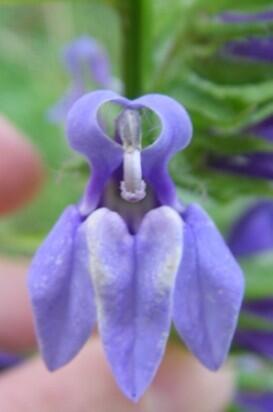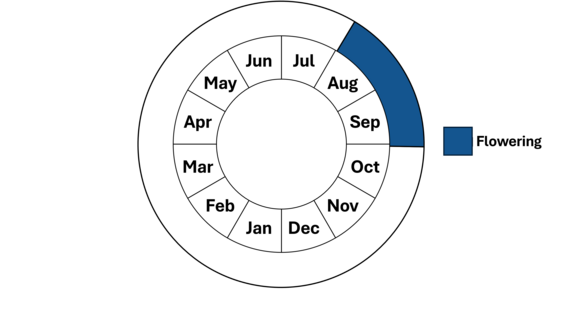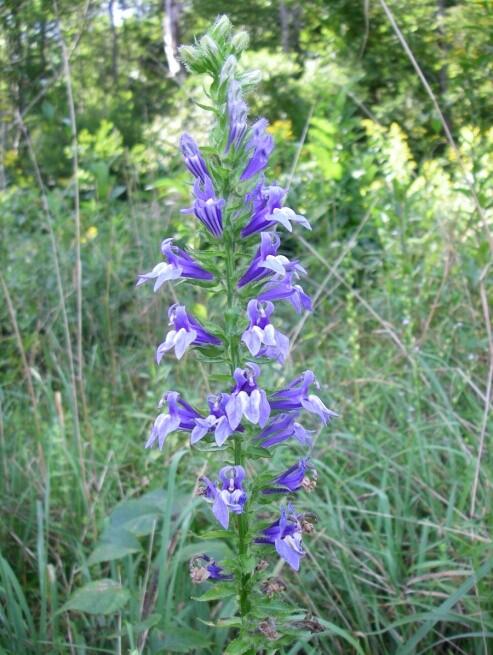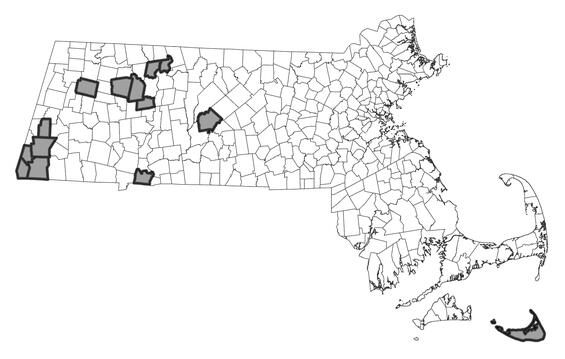- Scientific name: Lobelia siphilitica
- Species of Greatest Conservation Need (MA State Wildlife Action Plan)
- Endangered (MA Endangered Species Act)
Description

Photo by Marybeth Hanley.
Great blue lobelia (Lobelia siphilitica) is a tall, showy, perennial wildflower of the bellflower family (Campanulaceae) that grows in moist to wet open sites with circumneutral soils. Plants are stout and erect, up to 1.5 m (5 ft) in height. The sessile leaves, arranged alternately, are generally oblanceolate and are irregularly toothed along the margins. This plant’s most recognizable feature is its inflorescence: a crowded raceme of striking blue-purple tubular flowers nestled in leafy bracts.
Great blue lobelia has an angular, pubescent stem, which emerges from a central taproot. The leaves, which can vary in shape (oblong, elliptic, oblanceolate, or lanceolate), are mostly 8-12 cm long (~3-4 in), thin, and narrowed toward the base. The noteworthy inflorescence is a sizable raceme (10-30 cm; ~ 4-12 in) made up of multiple blue-purple (rarely white) flowers. The corollas (petal whorl) is fenestrate (with a slit or “window”) on each side near the base, and irregular; the lower side is three-lobed, and the upper lip is two-lobed and split nearly to the base. The base of the three-lobed lip is white, with two tubercles. The filaments and anthers are fused together into a tube with the lower two anthers shorter and bearded at the tip. The style grows up through the tube; the stigma is two-lobed. The calyx is distinctive, comprising foliaceous, pubescent bracts that are basally lobed with auricles (ear-shaped appendages). The fruits are two-chambered capsules that split open at maturity to disperse copious tiny seeds. Great blue lobelia flowers in late summer.
When great blue lobelia is flowering, it is unlikely to be confused with any other species. Common Lobelia species that might occur in the same habitat have much smaller flowers that lack fenestration.
Life cycle and behavior
This is a perennial species.

Population status

Photo by Marybeth Hanley.
Great blue lobelia is listed under the Massachusetts Endangered Species Act (MESA) as endangered. All listed species under MESA are protected from killing, collecting, possessing, or sale and from activities that would destroy habitat and thus directly or indirectly cause mortality or disrupt critical behaviors. This plant was formerly cultivated for its medicinal properties and continues to be a popular garden plant. The Massachusetts Natural Heritage & Endangered Species Program has 26 records from 4 counties: Berkshire, Franklin, Hampden, and Worcester. Nineteen of these records have been observed within the last 25 years.
Distribution and abundance
Great blue lobelia is known from Canada (Ontario and Nova Scotia) and from 36 of the 48 contiguous United States: most New England states south to Georgia, southwest to Texas, west to Wyoming and Colorado. It is presumed extirpated in Maine and possibly from Manitoba.

Distribution in Massachusetts. 2000-2025. Based on records in the Natural Heritage Database.
Habitat
In Massachusetts, great blue lobelia inhabits circumneutral wetland and transitional habitats (wet meadows, fens, swamps, stream sides, moist woodland borders, roadside ditches, and thicket edges of fields and old pastures). Plants generally favor open areas or those with light shade but have also been found in small openings of wooded areas or in shrub thickets. Many associated species occur with great blue lobelia due to the wide range of habitats that it occupies. In drier transitional habitats, such as thicket edges of fields and old pastures, species commonly encountered are hog-peanut (Amphicarpaea bracteata), wild bergamot (Monarda fistulosa), calico aster (Symphyotrichum lateriflorum), and late goldenrod (Solidago gigantea), along with several other weedy species and pasture grasses. In wetter habitats (such as stream sides), plants such as spotted joe-pye-weed (Eutrochium maculatum), orange jewelweed (Impatiens capensis), sensitive fern (Onoclea sensibilis), and fowl meadow-grass (Glyceria striata) occur with several other plants, depending upon the prevailing hydrologic regime.
Healthy habitats are vital for supporting native wildlife and plants. Explore habitats and learn about conservation and restoration in Massachusetts.
Threats
The exact management needs of great blue lobelia are not known. As with all species, however, maintaining habitat quality is essential. Populations are found in a range of habitats, though those with high plant abundance are open and receive periodic disturbance such as mowing and/or grazing. While plants may occasionally be found in semi-open wooded areas with light shade, they do not typically occur in large numbers under densely shaded, thickly vegetated conditions. For these reasons, natural succession and overshading from invasive species may pose a threat to this species.
Conservation
Maintaining open areas of vigorous populations by managed disturbance is crucial. Disturbance can spawn the establishment of invasive exotic plant species that can out-compete native plants for nutrients and light, and great blue lobelia’s habitat should be monitored for these species. Invasive plants of concern are oriental bittersweet (Celastrus orbiculatus), multiflora rose (Rosa multiflora), Japanese barberry (Berberis thunbergii), and reed canary grass (Phalaris arundinacea). If exotic plants are invading great blue lobelia’s habitat, a plan for control should be constructed. All active management within the habitat of a rare plant population (including invasive species removal) is subject to review under MESA and should be planned in close consultation with MassWildlife’s Natural Heritage & Endangered Species Program.
Contact
| Date published: | April 30, 2025 |
|---|